Dear Friends and Followers. Please note, I am once again having continual service issues with IONOS, the company that hosts the blog. My “tech support,” dear brother Don, is helping to get it resolved. But meanwhile, if you attempt to comment and receive “access denied”, please let me know via email at suzanne@taketothehighway.com, wait a few hours, and please try again. Sorry for the frustrating circumstances, but thanks for sticking with me. ~Suzanne
I booked my overland trek through Sudan and Ethiopia with a UK-based company, “Dragoman.” They’ve been in business since 1981, still owned by the original founders, specializing in overland travel all around the globe. They have a fleet of 30 purpose-built overlanding trucks built in Suffolk, UK, and shipped around the world. They are billed as active tours that get off the beaten track and interact with locals in the more remote sites. We would be traveling in a giant orange truck with a Mercedes engine and integrated cab, 24 coach-style seats with two tables, and a large refrigerator, with 350 liter drinking water tank, fully equipped kitchen, camp chairs, and tents in the storage bins below.
Dragoman names their trucks, typically after notorious women. I would be spending 30 days traveling in “Amelia,” named for Amelia Earhart, with our leader Louise and driver James, both from UK. (But I will let you in on a little secret…Louise was an even better driver than James!)

The Sudan Loop Group, featuring “Amelia” with Louise in the driver’s seat and James hanging off the mirror. Thankfully, we only had half this many on the Ethiopia loop!
The trip would be comprised of two loops…8 days through Sudan from Khartoum to Khartoum. Then we would cross the border into Ethiopia for another “lollipop” loop from Gondar to Addis Ababa. When I first booked this tour, I was told there were 22 passengers on board….almost a full truck! I thought it would be the same group for the entire 30 days, but I was pleased to learn we would get a whole new group in Ethiopia. This was good news, because while we were near full on the first loop, there would only be 11 travelers on the 22 day loop, giving lots of room to spread out, and a guaranteed window seat.
On board were passengers from Australia, Ireland, England, Denmark, Netherlands, Germany, and much to my surprise, five US citizens. One of the main reasons I often book tour companies based outside the US is primarily because you don’t find these kind of tour operators based in the US, and if you do, they are ridiculously expensive. But I also enjoy traveling with people from other parts of the world. So I was surprised to learn there were four other US citizens on board, all who had come to Sudan specifically for this loop of the trip only (they had all four been to Ethiopia on previous trips.) Who knew word was out on Sudan already?
The Sudan loop would be very different than the Ethiopia loop, simply because once one leaves Khartoum, there really aren’t any “hotels” or even restaurants for that matter. So we would be wild camping in the Sahara desert for six nights, shopping for groceries in the local markets, and preparing our own meals.
There would be two opportunities to “upgrade” to a guesthouse along the way. These guesthouses were no more than several cots in a concrete-block room with a pillow and thin mattress on a wooden frame strung with twine for springs. There was no bedding, so one still had to sleep in a sleeping bag. But for only 150 Sudanese Pounds (three bucks) it was worth not having to pitch a tent in the wind and inflate a sleeping pad that night, then cram it all back in the duffel bag before sunrise. There was a squat toilet across the courtyard. If you have never used a squat toilet, well, it’s just as it sounds. Two opposing foot platforms (if you are lucky) straddling a hole in the ground. One of these two guesthouses had a “suicide shower” (electrical heating unit attached to the shower head) affording the only opportunity for a rinse-off during the week. Otherwise, baby wipes were our best defense. Thank goodness the weather was so surprisingly cool!
Camping in the bush under the magnificent stars was stunning, and in the early hours, I could see the Southern Cross low on the horizon. Then later in the week, the waxing moon reached full on our last camp night. All six nights, the skies were clear, air was dry and warm during the day, and cold at night, like most deserts. It was much cooler in Sudan than I expected, but I managed to stay warm inside the sleeping bag, and my new down “puffy” purchased for the trip is now well broken in.
I learned a valuable lesson after my first night of pitching a tent in the Sahara….one needs to “read” the dunes to study the shape and curvature before staking out a spot. Wind tunnels through troughs in the dunes, so steer clear of any “notches” on the nearby horizon, but rather use the sand banks as a wind break. While it was a comfortable sleep, I was concerned at times that I would wake up inside a skeleton of tent poles around me.
A little known fact (at least to me,) Sudan has more pyramids than Egypt. Yet unlike the Pyramids of Giza, there were no neon “Pizza Hut” signs flashing in the background, no taxi scams, and no lines waiting to enter. Every day, we would stop at least twice to visit ancient temples, fortresses, or historic sites, and with a few rare exceptions of the odd couple here or there, we would have the sites all to ourselves. I’ve never experienced tourism like that before. That alone made me grateful for the opportunity to visit Sudan.
Here are chronological scenes from the first half of the week, Khartoum to Meroë:

Our first historic stop on Day One was to see the beehive tombs and ruins of the old city of Dongola, once an important city in medieval Nubia.

Examples of the majority of grave sites in the cemetery, most marked with stones or metal markers. There are believed to be 20,000 grave sites here. I am unclear on why some got the beehive treatment. Likely priests or high-ranking officials.

The town of Old Dongola was in existence from the end of the 5th to the late 19th centuries. This was the “Throne Hall,” built in the middle of the 9th century. It served as a mosque from AD 1317 until the end of the 20th century. The walls are one meter (approx 3 ft) thick.
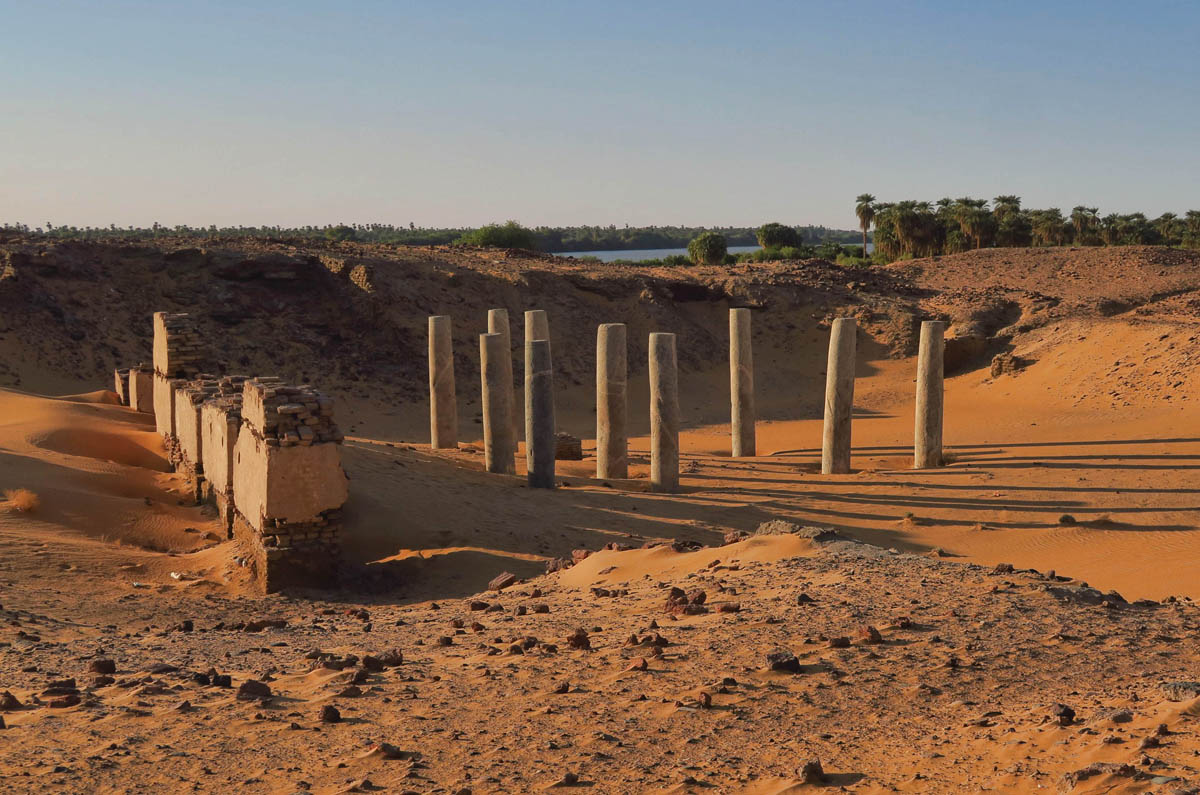
Ruins from the Temple of Kawa along the east bank of the Nile River (you can see the Nile in the background.)

Capitals have been removed from the temple columns, and are displayed next to a small museum.
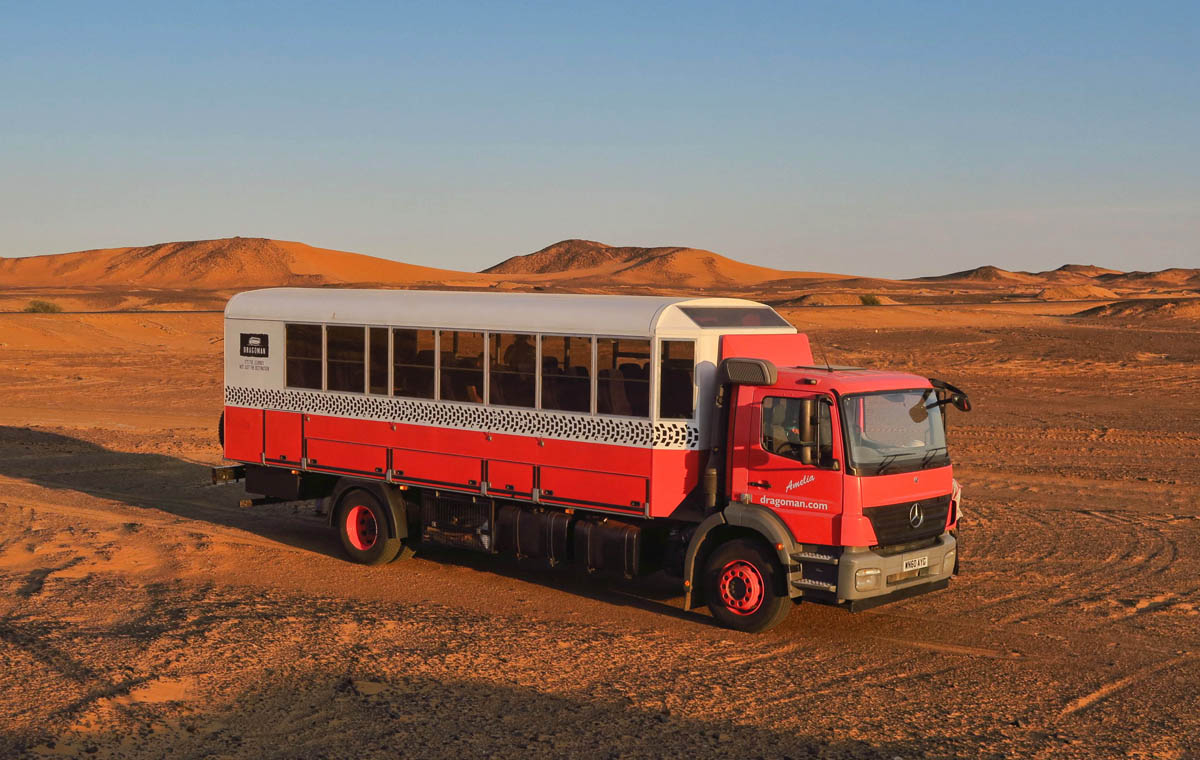
“Amelia” is very photogenic parked amidst the sands of the Sahara. We went offroad often, and fortunately she never got stuck.

Pitching tents on our first night of camping.

This is the view from my tent door waking up from our first night of camping in the Sahara.

It’s a very common site to see ornate mosques built along the highway.

This looks to be the local roadside repair shop. All of Sudan is a great advert for Toyota, as they are everywhere, and appear to hold their own in the desert for decades.

Toyotas haul all kinds of cargo! This one appears to be a taxi, a typical side of the road scene.

I have no recollection of where this door was located, but I love photos of old doors, so it goes in.
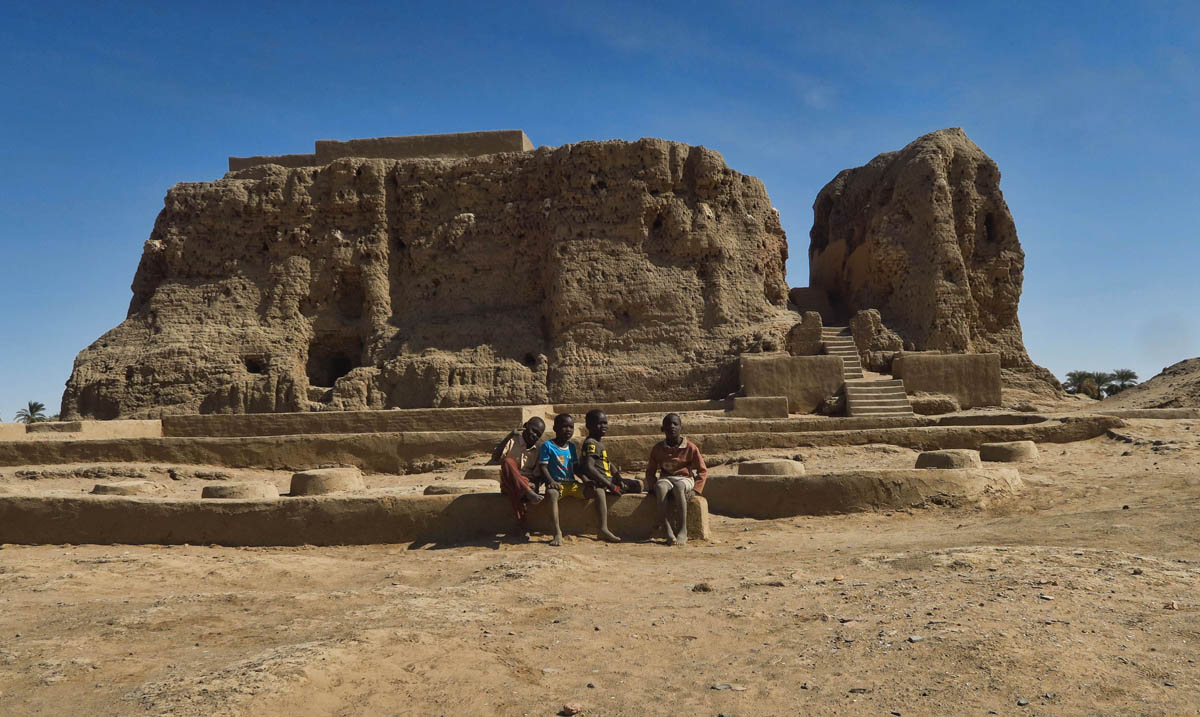
On Day Two, we visit Temple of Deffufa, a 5,500 year old Nubian archaeological site built from mud bricks by the Kerma civilization.

We are being watched. 😉 The children of Sudan are quite shy and undemanding, unlike the little monsters in Ethiopia. In Sudan, they just want to hold your hand while in Ethiopia, they want to empty it.

These seven statues referred to as the “Black Pharaohs” were only discovered in Jan, 2003, sealed in a cache in one of the tombs of the nearby Dukki Gel (meaning “red mound”) temples. They are believed to represent the last rulers of the twenty-fifth Egyptian dynasty.

On our second night of camping near the town of Wawa, we are offered an upgrade to sleep in the Nubian Guesthouse.

The upgrade was a welcome offering so as not to have to pitch my tent and inflate my sleeping pad. Even better, I wouldn’t have to “break camp” early the next morning!

For 150 Sudanese Pounds, the equivalent of three bucks, here is the upgrade…a cot in a concrete room and a squat toilet, but at least it didn’t require “staking” in the blowing sands 😉

Though some of us opted to upgrade, Amelia parked nearby as our portable kitchen and gathering place by the fire.

The following morning (Day Three) we would have a 4:00am wake-up call for a 4:30 am 20-minute walk down to the Nile, where we would board a small boat, cross the river, and watch the sun rise over the Temple of Soleb.

The Egyptian Temple of Soleb was built by Amenhotep III in the 14th century BC and was dedicated to Amun, Egyptian God of the Sun. The temple layout is very similar to the one in Luxor, also built by Amenhotep. The temple was once guarded by two red granite lions, now displayed in the British Museum.

The ambiance in the early morning hours was one of quiet reserve as locals moved swiftly about their morning routine.
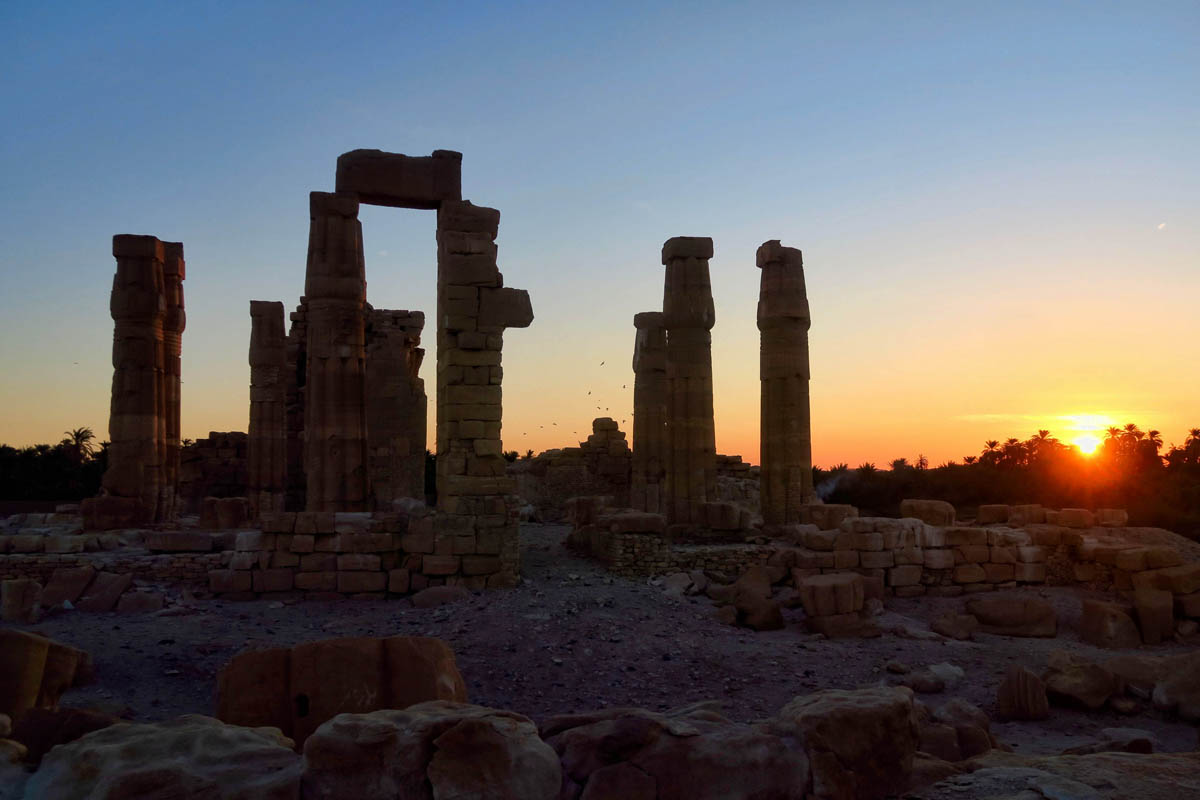
Watching the details on the columns take shape as the light lifts the darkness, the detail emerges to show concave fluted columns instead of the typical convex.
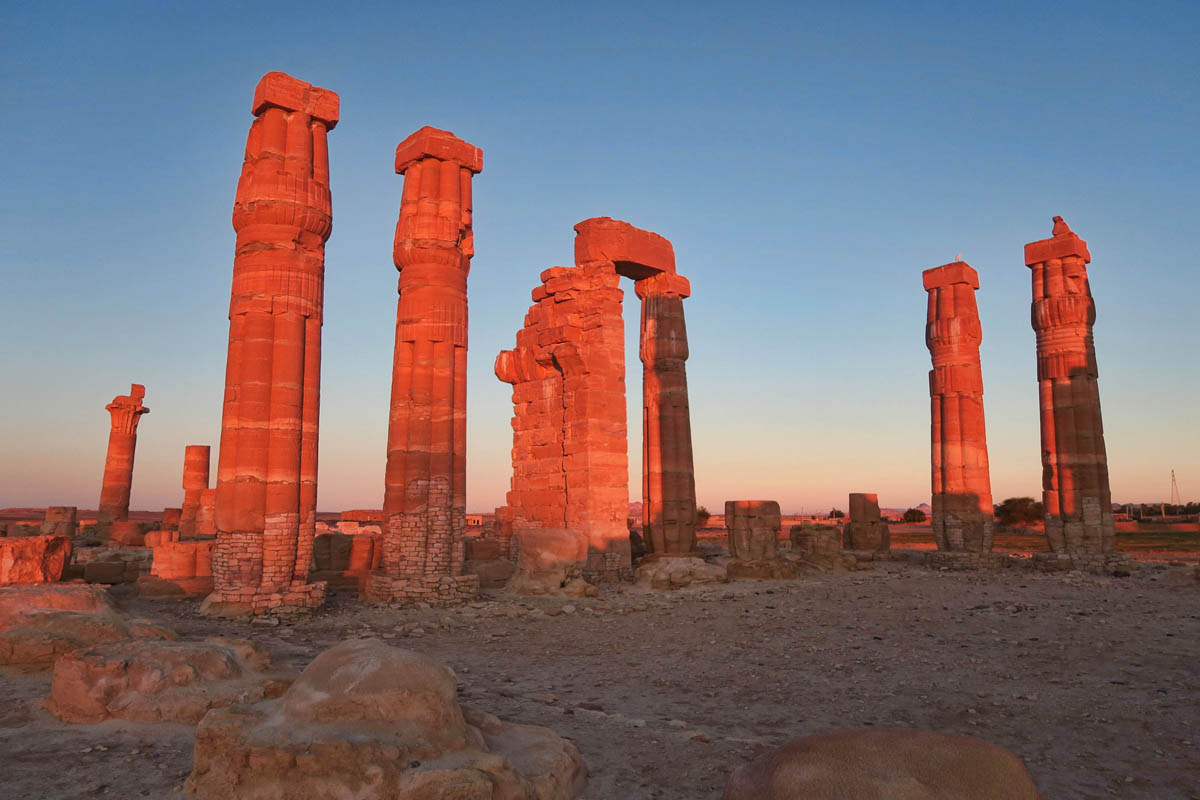
Sunrise highlights red granite of the temple.

Our boat, coming back across the Nile to pick us up once the sun has risen.
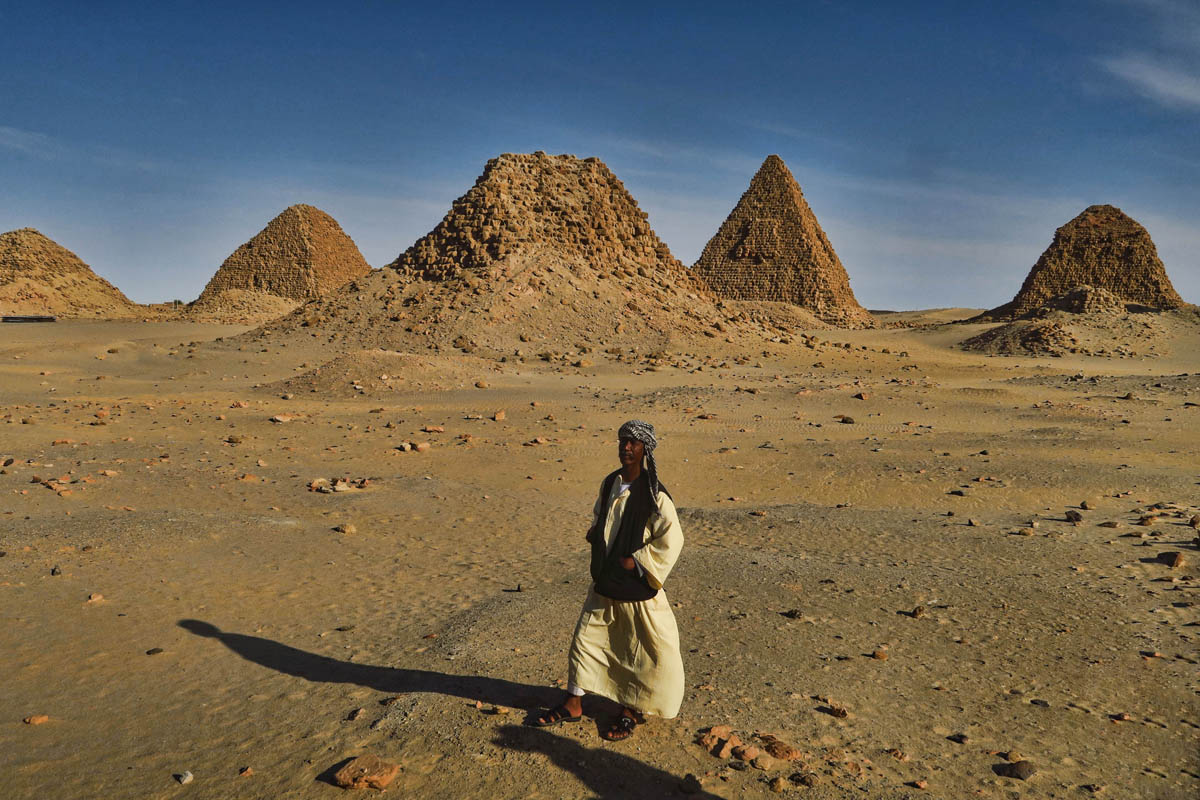
Leaving Wawa, we stop outside of Karima to see the Royal Nubian pyramids. Nuri, a royal burial site with 20 pyramids built 650 to 300 BC by the Kushites, and served as a royal necropolis for the ancient city of Napata, the first capital of the Nubian Kingdom of Kush. There are many differences between Sudanese and Egyptian pyramids. They are smaller, with steeper sides. But unlike Egyptian pyramids where the tomb is inside, in Sudan, it is underneath.

This small 322 ft high mountain is called “Jebel Barkal” which means “sacred mountain” in Arabic. We are going to climb it to watch the sunset.

Fifteen pyramids dot the landscape around the once-sacred monolith. Jebel Barkal served as a royal cemetery with the earliest burials dating back to the 3rd century BC.

Headed to the top, with Keryn from Australia not far behind me. (Note small group of pyramids in the backdrop.)

Temperatures on top of the breezy mound drop faster than the setting sun.

The path up the mountain was rugged with a lot of loose rock. I am relieved to learn there is a softer, gentler way down. 😉

We overnight in nearby Karima, but return the next morning to tour the temple ruins at the foot of the Jebel Barkal mountain.
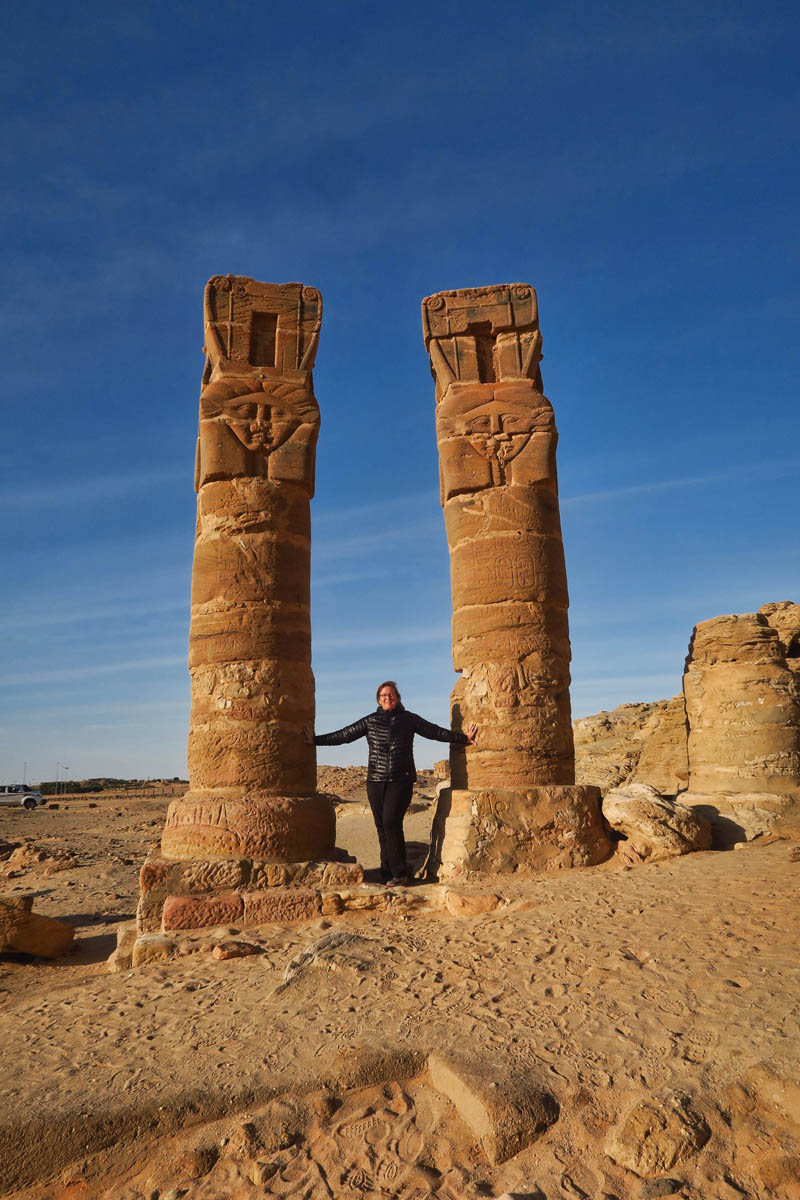
I wonder if I were to return here in 10 years time, will there be a fence around the ruins with signs, “Do Not Touch.”

Inside the tomb in the mountain are beautiful wall carvings embossed with blue paint, giving the walls the feel of fine Wedgewood china.

It’s my group’s turn to cook dinner, so we stop for a shop in the Karima local market. While Sudan offers lots of vegan options, this is not one of them. (Did they have to leave the tails on??)
Next Up: Sudan’s most famous tourist attraction, the Meroë Pyramids, and the second half of the loop, Meroë back to Khartoum.

Ooh, I’ve been waiting for another post. 🙂 Sudan looks amazing so far!
We are gobsmacked by what you are sharing! Thank you so very much. Our American educations are so lacking on including this fascinating part of the world. We are fascinated on the nightly accommodations having begun our travels over 50 years ago with tents and privys, but long ago graduated to roadside restaurants and restaurants. Of course ours was an economic decision, not an availability one. You are giving us google goals that will take months to fill. thanks
allen and deede
I bow down with admiration of your willingness to be roughing it. I think I’m not built for overlanding. The bus is great! Thanks for sharing a location I will probably not ever see.
Gobsmacked is a good word. What a wonderful opportunity!
I too read the first comment of this post and thought “yeah gobsmacked is exactly the right word”!!!! So that makes me the third reader who’s been gobsmacked by Suzanne’s fantastic adventures.
Goodness, Suzann. You are wandering worlds I have never thought about much less seen. What an amazing way to travel. Always on the travel edge so few of us dare to go.
Count me in as gobsmacked as well. These blog posts are captivating!
Gobsmacked am I too. So smart to book a foreign tour.
What an adventure, makes me want to learn more about Sudan
Wow, I find the Black Pariahs fascinating. Makes you wonder what else is out there waiting to be discovered.
Wow! Wow! Wow! The archeology and history is amazing! Those red granite temples and blue painted carvings and historic burials and beehive graves! Yep, “gobsmacked” says it all! And this: “…unlike those little monsters in Ethiopia…” Hahahaha! I’ve had a tiny taste of overlanding, but this? This takes the cake!
I’ve never in my life wanted to be thought of as a stalker. But, daaaang, please, please consider taking me along on some future, wondrous trek, Suzanne. I promise with all my heart I will stay at least five steps behind you and never speak unless spoken to. Pinky promise, even!
I can’t wait til your next installment…You got spunk, girl. I so admire spunk! 🙂
What an incredible journey! Amazing sights and photos…I am loving following your travels!
This reminds me so much of Egypt. My parents lived there for three years and we flew over to visit. I’ll never forget the first time we saw the “squat” toilet!! Not for us!! It was 30 years ago we went and thing were much more rustic than today. They leave the tail on the animal so you will know what it is. This was how my mother would shop for meat. This was the only vacation I lost weight on!!! Your photos are spectacular. Your are one brave lady!! I am sharing your posts with my mother. This is her idea of places to visit.